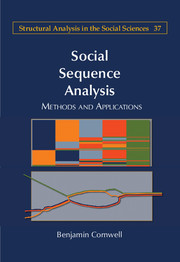Book contents
- Frontmatter
- Contents
- List of Figures
- List of Tables
- Preface
- Acknowledgments
- PART I INTRODUCTION
- PART II THEORETICAL BACKGROUND
- PART III SOCIAL SEQUENCE ANALYSIS CONCEPTS AND TECHNIQUES
- PART IV NEW DIRECTIONS IN SOCIAL SEQUENCE ANALYSIS
- 6 Network Methods for Sequence Analysis
- 7 Social Microsequence Analysis
- PART V CONCLUSIONS
- Appendix A Recent Whole-Sequence Pattern Analyses
- Appendix B Linkage Criteria for Agglomerative Hierarchical Clustering
- References
- Index
- Recent Books in the Series (continued from page iii)
7 - Social Microsequence Analysis
from PART IV - NEW DIRECTIONS IN SOCIAL SEQUENCE ANALYSIS
Published online by Cambridge University Press: 05 July 2015
- Frontmatter
- Contents
- List of Figures
- List of Tables
- Preface
- Acknowledgments
- PART I INTRODUCTION
- PART II THEORETICAL BACKGROUND
- PART III SOCIAL SEQUENCE ANALYSIS CONCEPTS AND TECHNIQUES
- PART IV NEW DIRECTIONS IN SOCIAL SEQUENCE ANALYSIS
- 6 Network Methods for Sequence Analysis
- 7 Social Microsequence Analysis
- PART V CONCLUSIONS
- Appendix A Recent Whole-Sequence Pattern Analyses
- Appendix B Linkage Criteria for Agglomerative Hierarchical Clustering
- References
- Index
- Recent Books in the Series (continued from page iii)
Summary
The purpose of this chapter is to show how applying the various methods that are described in this book has the potential to transform an area of research by opening up the possibility of asking new research questions using new analytical tools. The least developed but most promising application of the various social sequence analysis methods described in this book is the study of microsocial action sequences, or social microsequences(Gershuny 2000). This context of social action is currently dominated by time use research. By thinking about action at this level a little differently – specifically, in terms of sequences – new questions and concepts leap to the fore.
A definition of this concept is provided later but, put simply, social microsequences characterize the ordered nature of everyday life. Action that occurs in sequence within a given individual's schedule on a given day – for example, “I took a shower, got dressed, and then I went to work” – are temporally connected as elements in larger chains of action. The analysis of this type of micro-time action is becoming an increasingly central research concern within the social sciences. Due to the rapid increase in the availability of secondary data concerning social activity on this time scale (see Fisher et al. 2012), drastic improvements in the technologies that are required to collect and analyze such data (e.g., smartphones, and software capable of analyzing large datasets), and growing interest in how everyday contact networks emerge and evolve, researchers are beginning to appreciate the feasibility and value of analyzing the structure of a field of action that was once regarded too complex for systematic analysis. As such, it is useful to develop new methods to supplement existing time use approaches.
The lessons from all of the previous chapters need to be brought to bear on this problem. For example, I show how OM can be used to identify holistic microsocial contact patterns during the course of a given day, and how sequence-network methods can be used to analyze the structure of synchrony and routine in everyday life. Overall, this chapter sketches the theoretical rational for studying action on this level, addresses the relevant analytical issues, and describes unique concepts and methods that are involved in the study of microsocial action.
- Type
- Chapter
- Information
- Social Sequence AnalysisMethods and Applications, pp. 210 - 252Publisher: Cambridge University PressPrint publication year: 2015



